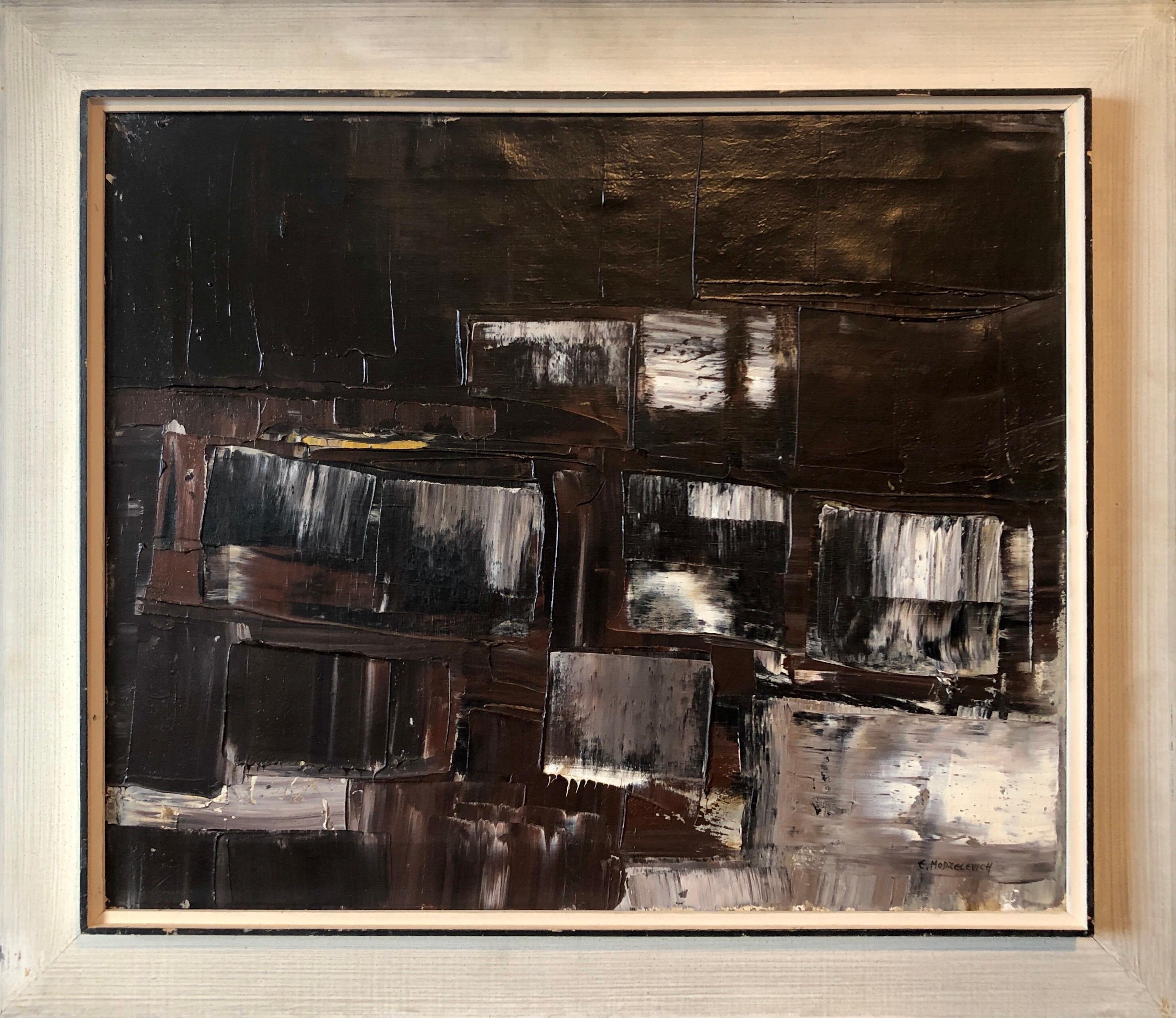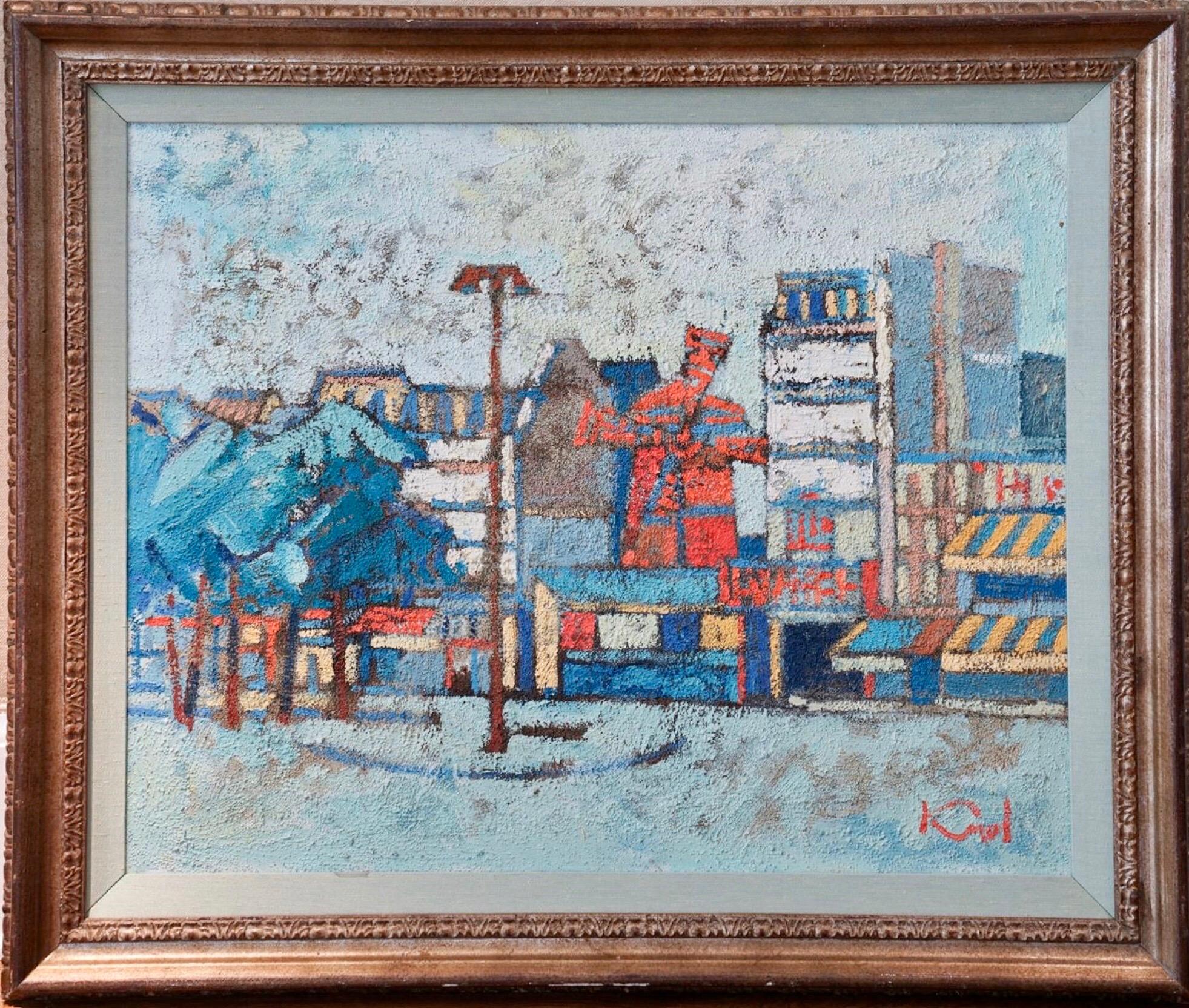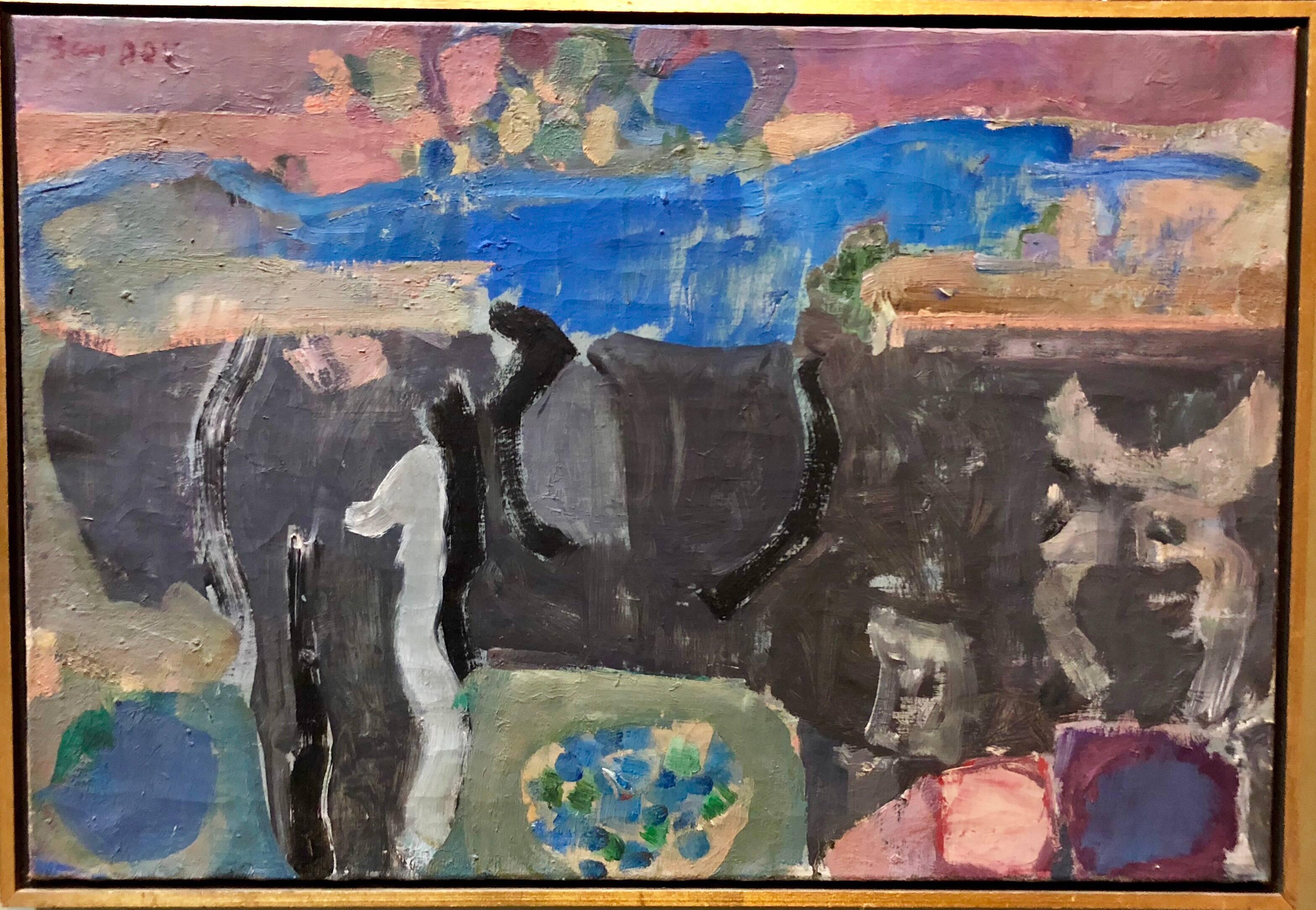Items Similar to Vintage Exhibited Modernist Abstract Maine Seascape Signed Framed Oil Painting
Want more images or videos?
Request additional images or videos from the seller
1 of 11
UnknownVintage Exhibited Modernist Abstract Maine Seascape Signed Framed Oil Painting1950
1950
About the Item
Antique American modernist Maine landscape oil painting. Oil on canvas. Signed. Framed. Image size, 40L x 36H.
- Creation Year:1950
- Dimensions:Height: 37 in (93.98 cm)Width: 41 in (104.14 cm)Depth: 2 in (5.08 cm)
- Medium:
- Movement & Style:
- Period:
- Condition:
- Gallery Location:Buffalo, NY
- Reference Number:1stDibs: LU139212202502
About the Seller
4.9
Platinum Seller
These expertly vetted sellers are 1stDibs' most experienced sellers and are rated highest by our customers.
Established in 1970
1stDibs seller since 2015
2,383 sales on 1stDibs
Typical response time: 1 hour
- ShippingRetrieving quote...Ships From: Brooklyn, NY
- Return PolicyA return for this item may be initiated within 2 days of delivery.
More From This SellerView All
- Antique Southern School Civil War Cannon Modernist American Landscape PaintingLocated in Buffalo, NYNice quality modernist painting. Oil on canvas. Framed. Image size, 16L x 12H.Category
1930s Modern Landscape Paintings
MaterialsCanvas, Oil
- Vintage Mid Century Fauvist American Modernist Amusement Park Oil PaintingLocated in Buffalo, NYA Painting depicting an amusement park exploding in vibrant colors. The painting is signed "William Wright" lower right. Oil on Canvas. 20 x 24. Nicely framed.Category
1940s Modern Landscape Paintings
MaterialsCanvas, Oil
- Vintage American School Abstract Original Surreal Sky Study Oil PaintingLocated in Buffalo, NYAntique American modernist abstract painting. Oil on board, circa 1950. Unsigned. Image size 20L x 10H. Housed in a period modern frame.Category
1950s Modern Abstract Paintings
MaterialsCanvas, Oil
- Antique American Modernist New York City Street Scene Abstract Oil PaintingLocated in Buffalo, NYAntique American modernist signed original oil painting. Oil on canvas, circa 1930. Signed illegibly. Image size 20L x 16H. Housed in a period giltwood frame.Category
1920s Modern Landscape Paintings
MaterialsCanvas, Oil
- Antique American Mid Century Modern Cubist Abstract Architectural Oil PaintingLocated in Buffalo, NYVintage American school modernist painting. Oil on canvas, circa 1940. Unsigned. Image size, 30L x 24H. Housed in a period frame.Category
1940s Modern Landscape Paintings
MaterialsCanvas, Oil
- Buffalo New York Regionalist Modern Landscape Signed Exhibited Rare Oil PaintingLocated in Buffalo, NYAntique American modernist landscape painting signed "Welch '42". Oil on board, circa 1942. Signed. Image size, 16L x 14H. Housed in a modern frame.Category
1940s Modern Landscape Paintings
MaterialsCanvas, Oil
You May Also Like
- Reeds 7 March 09:13 - Modern Nature Oil Painting, Abstract, MinimalismBy Robert MotelskiLocated in Salzburg, ATRobert Motelski's paintings are exceptional visions of nature, visions of space which surrounds us. They tell about being, fate and passing. They depend on the season of year, the ti...Category
2010s Modern Landscape Paintings
MaterialsCanvas, Oil, Acrylic
- 1963 Vintage Mid-Century Abstract Seascape Oil Painting - Coastal ThunderstormLocated in Bristol, GBCOASTAL THUNDERSTORM Size: 52.5 x 70 cm (including frame) Oil on Canvas An emotive and wonderfully executed mid-century abstract artwork, painted in oil onto canvas and dated 1963. ...Category
1960s Modern Landscape Paintings
MaterialsCanvas, Oil
- Israeli Modernist Abstract Expressionist Seascape Oil Painting Tel Aviv HarborBy Motke BlumLocated in Surfside, FLIn this artwork the artist uses the medium spontaneously .The paint has been applied thickly to the surface. The resulting work emphasizes the physical act of painting itself as an essential aspect of the finished work or concern of the artist. size is with frame. Motke Blum was born in Racacun, Romania in 1925. Early in his childhood, the Blum family moved to Bukarest where they settled in a house situated near a circus. The circus would become young Blum's greatest love. He befriended several of the clowns and other performers and, when not painting or playing in clay, Blum could be found enjoyoing the company of these spirited entertainers. These experiences would later become a recurring theme in many of his works of art. In 1938, he was taken by the Romanian Iron Guard. When the Germans invaded Romania, Blum was taken to a forced labor camp. Even during his imprisonment, he continued to create art, painting on the walls of the camp. He escaped the camp in 1944 and boarded an immigrants' ship to Israel. One of the three ships in the convoy was sunk by a German torpedo. Motke later incorporated shipwrecks, boats, and other maritime subjects into several of his paintings. Over the course of his long and fruitful career, Blum showed internationally at over fifty one-man-shows with exhibits in Israel, Holland, England, Belgium, the United States, France, Australia, and more. His art has been commissioned for public buildings and by prominant figures in Israel and around the world, and a series of posters were commissioned by the Justice Ministry and the Ministry of Tourism. Giving back to the community has been a focus throughout his life. After establishing a studio at Chutzot Hayotzer, Motke welcomed schools and both adults and children with special needs, using painting...Category
Mid-20th Century Modern Abstract Paintings
MaterialsCanvas, Oil
- Israeli Modernist Abstract Expressionist Jerusalem Kotel Oil Painting JudaicaBy Efraim ModzelevichLocated in Surfside, FLEfraim Modzelevich (1931-1995) Work is abstract in subject, and expressive in terms of technique. The artist uses a muted color palette, and thick layers of paint to build up his co...Category
Mid-20th Century Modern Abstract Paintings
MaterialsCanvas, Oil
- Large Polish French Paris Scene Mid Century Modernist Oil Painting Moulin RougeBy Abram KrolLocated in Surfside, FLWonderful scene of the Moulin Rouge cabaret nightclub at Place Pigalle in Paris. Painted in wonderful moody blue and red colors. Size includes frame. Abram Abraham Krol was born January 22, 1919, in Pabianice (Lodz), Poland. Abram Krol went to France in 1938 to study civil engineering at the University of Caen. In 1939 at the beginning of World War II he joined the Foreign Legion. After he was demobilized, he became a mechanic in a garage in Avignon. Although Jewish, he survived the war with a false identity. In 1943, Krol started studying to be an artist, taking courses in sculpture at the city’s School of Fine Art. He also began studying painting and self-described himself as a “Sunday painter.” Krol moved to Paris in 1944. The first exhibition of his work was in 1946 in the Katia Granoff Gallery in Paris. After the war, Krol took up engraving, studying that art form with an engraver he met in Paris. Krol reflected his Hasidic childhood often using Biblical themes in his art works. He said, During all my years of childhood I had read the Bible endlessly. I came back to the Bible because I was on solid ground there. It was part of the assertion of my own truth after a time of complacency. It seemed to me that in painting or engraving there were so many reefs to avoid, so many possibilities of setback, that I had to have all the odds in my favor do what I could—say what I had to say. Krol illustrated over 20 literary works from the late 1940s through the 1960s. He also engraved medals for the Paris mint and painted murals for schools in France. He designed tapestries and painted approximately 200 enamels. Museums and libraries which own Krol’s art works include the Bibliotheque Nationale in Paris; the Victoria and Albert Museum in London; the British Museum; Houghton Library, Harvard; Bodleian Library, Oxford, and the Palace of the Legion of Honor in San Francisco. Krol has had numerous one-man shows throughout Europe, Brazil, and in California. In 1960, Krol was invited to the Venice Biennale. He was awarded the Critics Prize in 1958. He also won the Feneon Prize among other honors. Krol died on October 9, 2001. The School of Paris, Ecole de Paris, was not a single art movement or institution, but refers to the importance of Paris as a center of Western art in the early decades of the 20th century. Between 1900 and 1940 the city drew artists from all over the world and became a centre for artistic activity. School of Paris was used to describe this loose community, particularly of non-French artists, centered in the cafes, salons and shared workspaces and galleries of Montparnasse. Before World War I, a group of expatriates in Paris created art in the styles of Post-Impressionism, Cubism and Fauvism. The group included artists like Pablo Picasso, Marc Chagall, Amedeo Modigliani and Piet Mondrian. Associated French artists included Pierre Bonnard, Henri Matisse, Jean Metzinger and Albert Gleizes. The term "School of Paris" was used in 1925 by André Warnod to refer to the many foreign-born artists who had migrated to Paris. The term soon gained currency, often as a derogatory label by critics who saw the foreign artists—many of whom were Jewish—as a threat to the purity of French art. Art critic Louis Vauxcelles, noted for coining the terms "Fauvism" and "Cubism", Waldemar George, himself a French Jew, in 1931 lamented that the Ecole de paris, School of Paris name "allows any artist to pretend he is French. it refers to French tradition but instead annihilates it. The artists working in Paris between World War I and World War II experimented with various styles including Cubism, Orphism, Surrealism and Dada. Foreign and French artists working in Paris included Jean Arp, Joan Miro, Constantin Brancusi, Raoul Dufy, Tsuguharu Foujita, artists from Belarus like Michel Kikoine, Pinchus Kremegne, and Jacques Lipchitz, the Polish artist Marek Szwarc and others such as Russian-born prince Alexis Arapoff. A significant subset, the Jewish artists, came to be known as the Jewish School of Paris or the School of Montparnasse. The core members were almost all Jews, and the resentment expressed toward them by French critics in the 1930s was unquestionably fueled by anti-Semitism. Jewish members of the group included Emmanuel Mané-Katz, Chaim Soutine, Adolphe Féder...Category
1950s Modern Landscape Paintings
MaterialsCanvas, Oil
- Lyrical Abstract Israeli Expressionist Oil PaintingBy Hanna Ben DovLocated in Surfside, FLHanna Ben Dov is an Israeli abstract painter who was born in Jerusalem in 1919 and died in Paris in 2008. Ben Dov's father, Yacov Ben-Dov, was a famous Israeli photographer who founded the photography department in the Bezalel Academy of Art and Design in 1910. Hannah herself attended Bezalel during the 1940s, and later continued to Camberwell College of Arts in London. After the completion of her formal education she moved to Paris, where she exhibited for the first time in 1948 and has been living and working there since, as a part of the local abstract artists school. She took part in the first French Biennale of 1951, that was held in Menton. Collections Her paintings can be found in several collections, including the French State Collection, the Tel Aviv Museum of Art collection, the Bezalel National Museum collection in Jerusalem and the Rockefeller Museum collection in New York. Ben Dov resided for her last two years at the Maison Des Artistes Home in Nogent-Sur-Marne, France, just outside Paris. Exhibitions Gallery97 Tel Aviv Paintings...Category
20th Century Modern Landscape Paintings
MaterialsCanvas, Oil
Recently Viewed
View AllMore Ways To Browse
Antique Vintage Frame
Vintage Painting Frames
Vintage Oil Sign
Vintage Sign Painting
Unknown Vintage Painting
Modernist Landscape Oil Painting
Oil Maine Landscape
Vintage Oil Signs
Vintage Modernist Frame
Modern Seascape Painting
Retro Seascape Paintings
Oil On Canvas Vintage Landscapes
Vintage Abstract Landscapes
Vintage Abstract Landscape Landscape
Retro Seascape Oil Painting
Oil Painting Seascape Modern
Antique Modernist Painting
Maine Antiques




